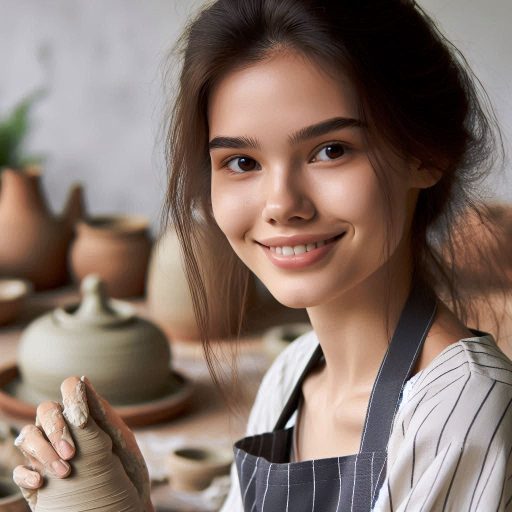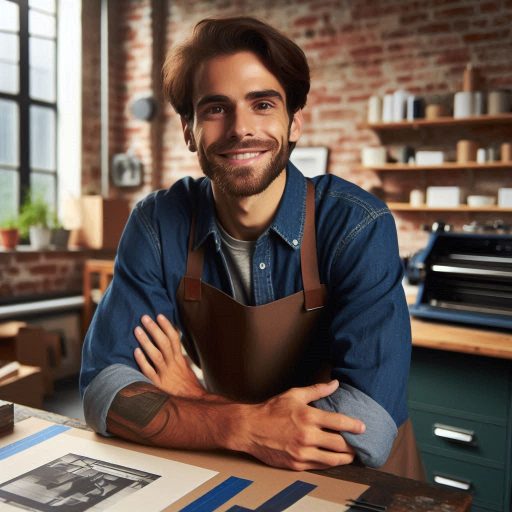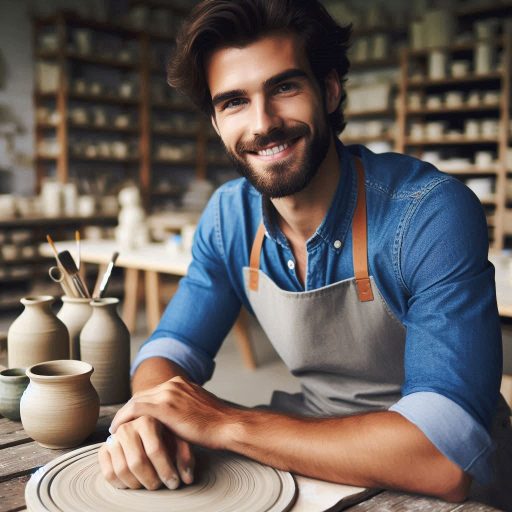Introduction
Incorporating printmaking into mixed media art opens exciting new avenues for creativity.
This fusion enhances traditional art forms by adding unique textures and layers.
Printmaking, with its diverse techniques, blends seamlessly into mixed media, enriching the overall artistic expression.
Printmaking techniques offer distinct benefits in mixed media artwork.
They introduce unique textures and patterns that cannot be easily achieved with other methods.
For instance, linocuts and etchings bring intricate details and depth.
These techniques allow artists to explore different dimensions within their work, creating dynamic visual interest.
The popularity of mixed media art continues to rise.
Artists seek ways to innovate and diversify their creative processes.
Printmaking provides an effective means to achieve this.
By integrating printmaking, artists can achieve complex compositions that engage viewers on multiple sensory levels.
The interplay of printmaking and other media, such as painting or collage, adds layers of meaning and visual intrigue.
Incorporating printmaking into mixed media art allows for endless experimentation.
Artists can combine traditional printmaking with contemporary techniques, pushing the boundaries of their work.
The results are pieces that are both visually stimulating and rich in texture.
This approach not only broadens artistic horizons but also deepens the emotional impact of the artwork.
In summary, incorporating printmaking into mixed media art enhances creativity and adds depth.
The blend of these techniques supports the growing trend in art, offering artists new ways to express themselves.
As mixed media continues to evolve, printmaking remains a vital tool for achieving innovative and captivating artistic results.
What is printmaking?
Printmaking as an art form that involves creating images on a surface, such as paper or fabric, using various techniques
Transform Your Career Today
Unlock a personalized career strategy that drives real results. Get tailored advice and a roadmap designed just for you.
Start NowPrintmaking is a dynamic art form that involves creating images on surfaces like paper or fabric.
This process uses various techniques to produce multiple copies of a single image.
Each method in printmaking offers unique visual results, making it a versatile tool in art creation.
An overview of different printmaking techniques, such as relief printing, intaglio, and screen printing
Relief printing is one technique where the artist carves or etches a design into a surface, such as wood or linoleum.
Ink is applied to the raised areas, and then the surface is pressed onto paper or fabric to transfer the image.
This method produces bold, textured prints with striking contrasts.
Intaglio printing involves carving or etching into a metal plate.
Ink is applied to the entire plate and then wiped off the surface, leaving ink only in the incised lines.
The plate is pressed onto paper under high pressure to produce detailed and nuanced images.
This technique is known for its fine line work and rich tonal range.
How printmaking can be used to add unique visual elements to mixed media art pieces
Screen printing uses a mesh screen to transfer ink onto a surface.
Areas not meant to be printed are blocked out, allowing ink to pass through only where desired.
This method is popular for its versatility and is often used for creating vibrant and repetitive patterns.
Incorporating printmaking into mixed media art adds unique visual elements.
Printmaking techniques can introduce distinct textures, patterns, and contrasts that complement other materials.
By integrating prints into mixed media pieces, artists enhance depth and visual interest.
Printmaking enriches the artistic expression by blending traditional and contemporary techniques, making each piece stand out.
Read: Top Ceramic Art Schools in the USA
Tools and Materials Needed for Printmaking in Mixed Media Art
Printmaking enriches mixed media art with texture and depth.
To get started, gather essential tools and materials.
Transform Your Career Today
Unlock a personalized career strategy that drives real results. Get tailored advice and a roadmap designed just for you.
Start NowEssential Tools and Materials
Begin with brayers, which are rollers used to apply ink evenly onto your printing surface.
Next, choose high-quality printmaking ink, available in various colors and types.
Carving tools, including gouges and knives, help in creating intricate designs on blocks or plates.
For printing surfaces, use materials such as linoleum, wood, or acrylic plates.
Each offers unique textures and impressions.
Additionally, have a good quality paper that can handle the ink and pressure of printing.
Combining Tools with Mixed Media Materials
Printmaking tools blend well with other mixed media elements.
Use brayers to apply ink over layers of paint for added texture.
Carved blocks can be printed over collages to integrate patterns with existing imagery.
Found objects like leaves or fabric can be pressed onto inked surfaces to create interesting textures and patterns.
Experiment by combining these tools with paints to enhance your prints’ color depth and surface variation.
Importance of Experimentation
Experimenting with different tools and materials is crucial.
Try various ink types, such as water-based or oil-based, to see how they interact with other mediums.
Test different paper weights and textures to understand how they affect the print‘s final appearance.
By mixing tools like carving knives with unexpected materials such as metallic foils or fabric scraps, you can achieve diverse and unique effects.
Embracing this experimentation will expand your creative possibilities and enrich your mixed media artworks.
Printmaking adds a distinct layer to mixed media art, offering endless creative opportunities.
Explore these tools and materials, and let your creativity guide your experimentation.
Read: Printmaking vs. Digital Printing: Key Differences

Techniques for incorporating printmaking into mixed media art
When it comes to incorporating printmaking into mixed media art, there are several techniques that can be employed to create visually dynamic and unique pieces.
Transform Your Career Today
Unlock a personalized career strategy that drives real results. Get tailored advice and a roadmap designed just for you.
Start NowBelow are some step-by-step instructions for creating a mixed media print using various printmaking techniques:
Monoprinting
Start by spreading a thin layer of printing ink on a smooth surface like Plexiglas.
Then, using various tools such as brushes, rollers, or even your fingers, create the desired imagery on the surface.
Collagraphy
For this technique, you can create a collagraph plate by using materials like cardboard, fabric, or even textured paper.
Apply ink to the plate and transfer the image onto paper by running it through a printing press.
Linocut
Carve out your design on a linoleum block using linocut tools.
Ink the block and then press it onto paper to create a print.
You can also experiment with multiple colors and layers for added depth.
Aside from these techniques, printmaking can also be combined with painting, drawing, and collage to create visually dynamic artworks.
Here’s how you can integrate printmaking with other mediums:
Combination with Painting
After creating a print, you can enhance it by adding layers of paint to bring out certain elements or create a more cohesive composition.
Use a variety of brushes and techniques to blend the print with the paint seamlessly.
Integration with Drawing
Drawings can complement printmaking by adding intricate details or defining certain areas of the composition.
Consider using different drawing tools like pencils, markers, or charcoal to create contrast and texture in your mixed media piece.
Incorporation with Collage
Collage elements can add a sense of depth and complexity to a printmaking piece.
Experiment with layering different materials like paper, fabric, or found objects on top of prints to create visually interesting textures and patterns.
Finally, when layering prints with other mixed media elements, consider the following tips to build depth and complexity in the composition:
- Experiment with transparency by layering prints on top of each other to create a sense of depth.
- Play with different textures and surfaces to add visual interest to your artwork.
- Consider using various adhesives or mediums to adhere different elements together securely.
- Balance the composition by strategically placing different elements to create a cohesive and harmonious artwork.
By incorporating printmaking into mixed media art and experimenting with various techniques, you can create truly unique and visually captivating pieces that showcase your creativity and artistic vision.
Read: How to Start a Career as a Ceramic Artist
Inspiration for incorporating printmaking into mixed media art
Examples of mixed media artists who successfully integrate printmaking into their artwork
Transform Your Career Today
Unlock a personalized career strategy that drives real results. Get tailored advice and a roadmap designed just for you.
Start NowPrintmaking adds texture and depth to mixed media art, enriching visual narratives.
Artists like Kara Walker and Jim Dine exemplify successful integration of printmaking.
Walker’s cut-paper silhouettes and prints create powerful social commentary.
Dine’s use of etching and woodcuts enhances his expressive, layered compositions.
Their work demonstrates how printmaking techniques can elevate mixed media art.
How different artists use printmaking techniques to convey meaning, emotions, and narratives in their mixed media pieces
Different artists employ printmaking to convey varied meanings and emotions.
For instance, Elizabeth Murray‘s vibrant, abstract prints are combined with collage elements to evoke dynamic energy and emotion.
Similarly, Robert Rauschenberg‘s combines silkscreen prints with found objects to tell complex stories and challenge traditional art boundaries.
These approaches show how printmaking can deepen the narrative and emotional resonance of mixed media art.
Encouragement to explore their creativity and experiment with incorporating printmaking into their own mixed media projects
Readers should explore and experiment with printmaking in their projects.
Try combining relief prints with acrylic paints or incorporating monotypes into collages.
Experiment with different printmaking techniques, like linocut or etching, to add unique textures and layers.
Each method can bring new dimensions to your artwork and enhance your creative expression.
By blending printmaking with mixed media, you can develop innovative, personal works that capture and communicate complex ideas and emotions.
Incorporating printmaking into mixed media art not only diversifies your artistic toolkit but also opens up new avenues for creativity.
Embrace the challenge, let your imagination guide you, and see how printmaking can transform your art.
Read: How to Build a Printmaking Portfolio
Learn More: Designing for Autonomous Vehicles
Challenges and Considerations When Incorporating Printmaking into Mixed Media Art
Combining printmaking with mixed media art can be thrilling but also challenging.
Artists often face several common obstacles.
Transform Your Career Today
Unlock a personalized career strategy that drives real results. Get tailored advice and a roadmap designed just for you.
Start NowAddressing Common Challenges
One major challenge is ensuring printmaking elements integrate well with other media.
Different materials can react unpredictably, affecting the final piece.
Managing drying times and ensuring proper adhesion of prints can be difficult.
Balancing textures and avoiding clashes between printmaking and other media often requires meticulous planning.
Solutions and Tips
To overcome these challenges, start with proper planning.
Sketch your idea and test materials on small samples before committing to the final piece.
Practice each technique separately to understand how they interact.
Experiment with different combinations to discover what works best.
Use a well-structured process to apply printmaking elements, allowing each layer to dry before adding new media.
This approach helps to avoid unwanted mixing and ensures better control over the final result.
Embracing Mistakes and Imperfections
Mistakes and imperfections are integral to the creative process in mixed media art.
Embracing these aspects can lead to unique and unexpected results.
View each mistake as an opportunity to explore new techniques and perspectives.
Allowing room for errors can enhance your creativity and lead to innovative solutions.
Remember, imperfections often contribute to the character and authenticity of the artwork.
Combining printmaking with mixed media art involves navigating various challenges.
However, with careful planning, practice, and a willingness to embrace mistakes, artists can create compelling and original works.
Each challenge offers a chance to learn and grow, contributing to the evolution of your artistic practice.
Conclusion
Incorporating printmaking into mixed media art offers a myriad of creative possibilities.
Printmaking techniques, such as linocut or screen printing, can add texture and depth to mixed media artworks.
Transform Your Career Today
Unlock a personalized career strategy that drives real results. Get tailored advice and a roadmap designed just for you.
Start NowThe combination of different mediums like collage, painting, and printmaking can result in unique and visually striking pieces.
The versatility of printmaking allows artists to experiment with various textures and patterns.
By blending traditional printmaking methods with modern mixed media practices, artists can push the boundaries of their creativity.
Printmaking offers a new dimension to mixed media artworks, opening up endless opportunities for artistic expression.
In the end, the integration of printmaking into mixed media art expands the artist’s toolkit and allows for a more dynamic and engaging artistic practice.
I encourage readers to explore and experiment with incorporating printmaking techniques into their own mixed media creations to discover the endless possibilities it can bring to their artwork.
[E-Books for Sale]
The Big Book of 500 High-Paying Jobs in America: Unlock Your Earning Potential
$19.99 • 500 High-Paying Jobs • 330 pages
Explore 500 high-paying jobs in America and learn how to boost your career, earn more, and achieve success!
See All 500 High-Paying Jobs of this E-Book
1001 Professions Without a Degree: High-Paying American Jobs You Can Start Now
$19.99 • 1001 Professions Without a Degree • 174 pages
Discover 1001 high-paying jobs without a degree! Unlock career tips, skills, and success strategies for just $19.99!




